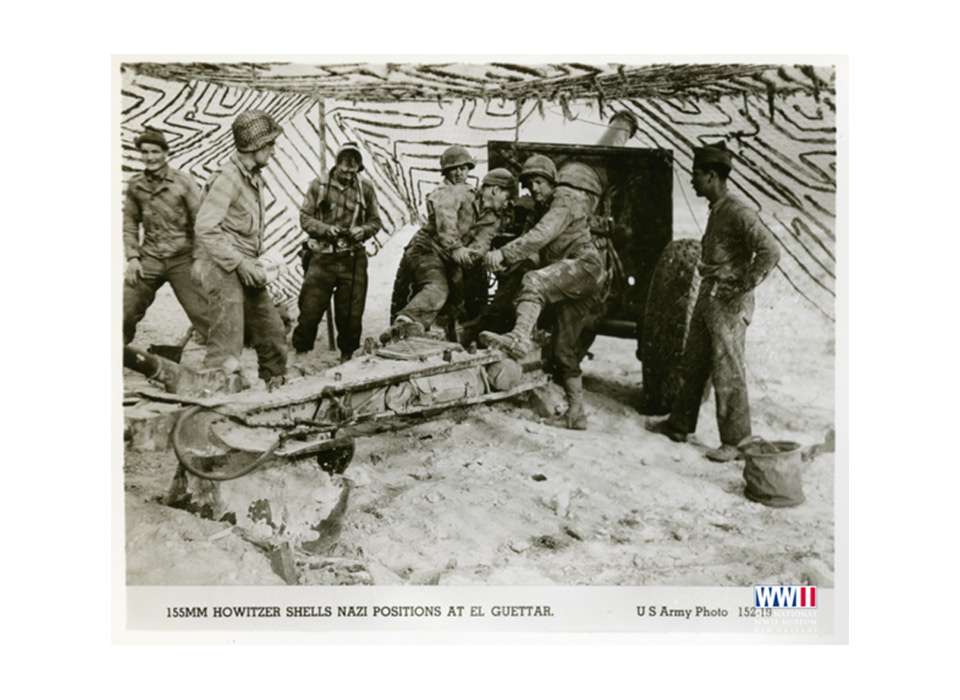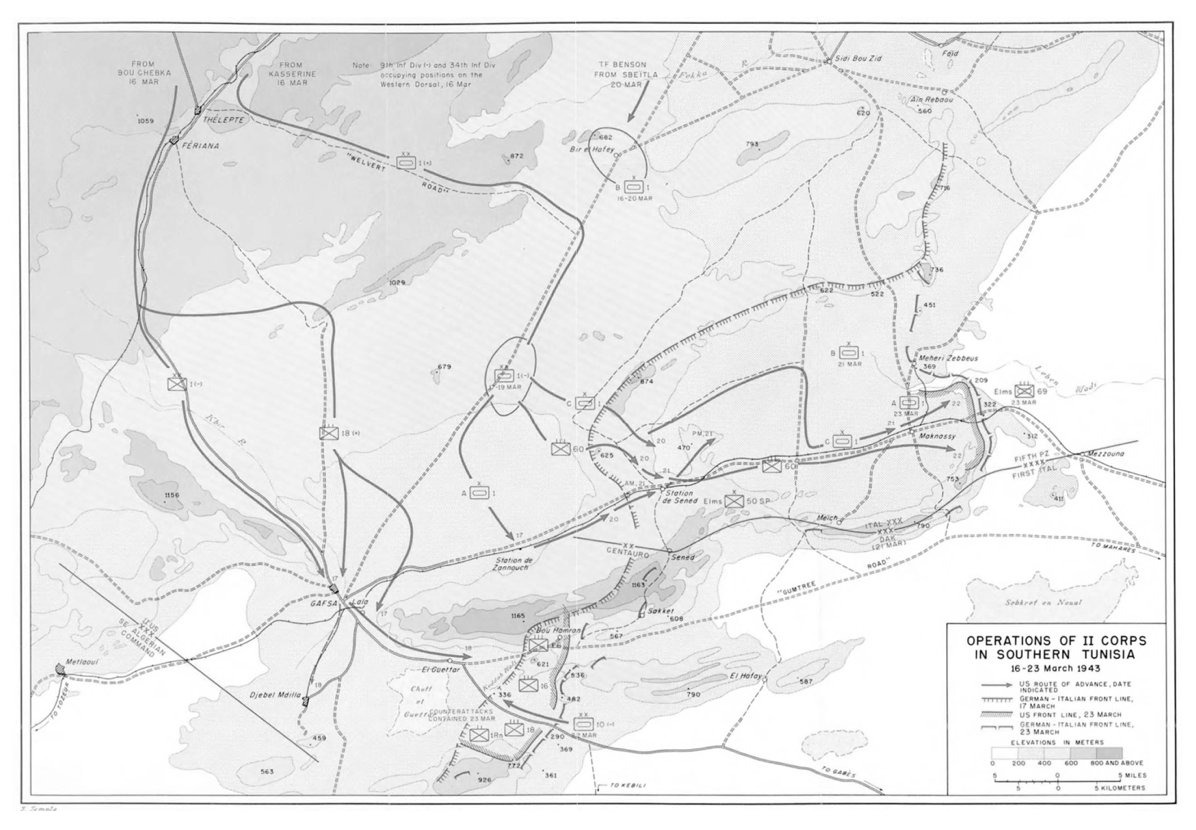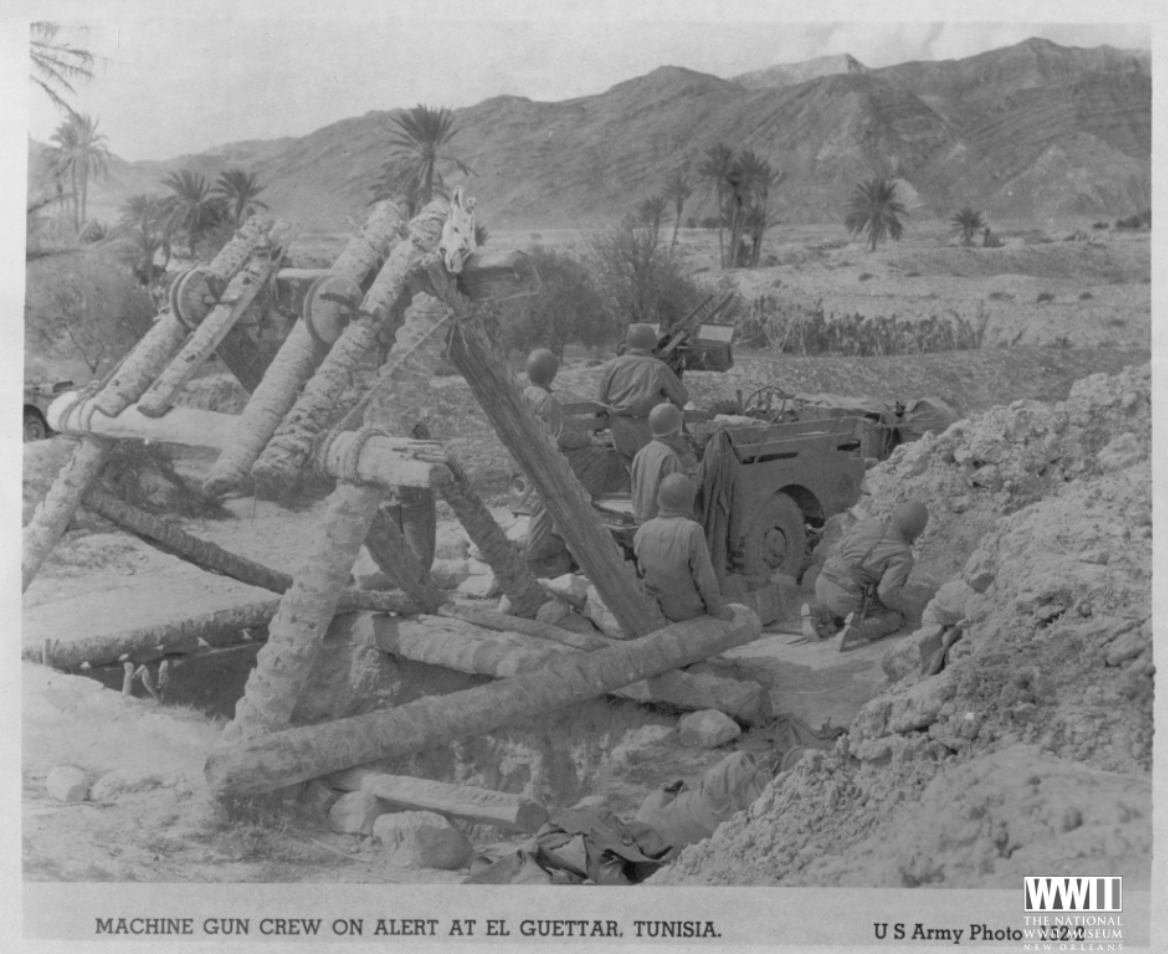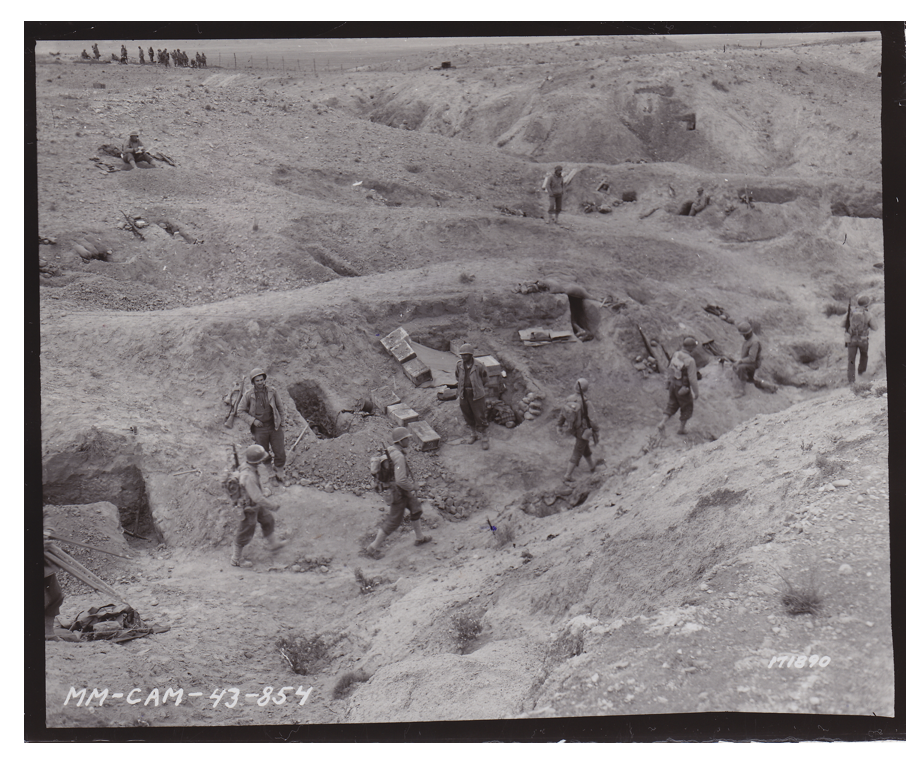Top image: US Army soldiers firing a M114 155mm Howitzer under camouflage netting. Official caption on front: “155mm Howitzer shells Nazi positions at El Guettar. US Army Photo 152-19.” El Guettar, Tunisia. No date. Courtesy The National WWII Museum. https://www.ww2online.org/image/us-army-soldiers-firing-m114-155-mm-howitzer-el-guettar
In the aftermath of the Battle of Kasserine Pass, US II Corps passed to the command of General Harold Alexander’s 18th Army Group. When Alexander took command on February 20, 1943, one of his first tasks was to assess II Corp’s combat readiness after its setbacks during its early engagements around Kasserine Pass. He was not impressed with what he saw, and his staff amplified his concerns with a report they prepared after a three-day tour of the front. The report reflected quite poorly on II Corps headquarters and its commander, Major General Lloyd Fredendall, but was more positive about both Major General Orlando Ward’s 1st Armored Division and the morale of American troops in general.
Having heard similar concerns about Fredendall’s suitability for command from other trusted sources, General Dwight D. Eisenhower decided to relieve him. He selected Major General George Patton as his replacement, assigning Major General Omar Bradley to Patton’s headquarters as his eyes and ears (realizing why Bradley was there, Patton chose to keep him close at hand by making him his deputy commander). Patton took command of II Corps on March 6, 1943, and quickly reviewed and approved plans for an offensive operation scheduled for March 17, less than two weeks away. Patton’s corps consisted of the 1st, 9th, and 34th Infantry Divisions, the 1st Armored Division, the 13th Field Artillery Brigade, and the 1st Ranger Battalion, plus seven battalions of the 1st Tank Destroyer Group distributed amongst the four divisions and the corps reserve.¹
Eisenhower and Alexander realized this powerful corps of 88,000 men needed to experience success in its coming engagements to raise confidence in its combat effectiveness, both within and outside the organization. They put measures in place to make this more likely. These included the assignment of battle-hardened liaison officers from the British Eighth Army to II Corps, replacement of the underpowered American 37mm antitank gun with the British 6-pounder, and augmentation of the corps’ combat divisions with 75 officers and 175 enlisted men from US 2nd Armored and 3rd Infantry Divisions.²
Alexander ordered Patton to clear Gafsa of enemy forces before continuing the attack to the east toward El Guettar, Sened Station, and Maknassy. These were limited objectives—there would be no drive to the coast. Rather, II Corps would protect the Eighth Army’s flank and draw off German defenders to ease the way for General Bernard Montgomery’s advance north from the Mareth Line towards Tunis. Alexander hoped that keeping Patton on a tight leash would result in a series of minor victories, building confidence in and among the soldiers of II Corps. With Field Marshal Erwin Rommel in southern Tunisia opposing Montgomery’s offensive, II Corps would face the Italian formations of the German Afrika Corps (DAK), reinforced by the understrength 10th Panzer Division, under the command of General Hans-Jurgen von Arnim.
When Ward’s 1st Armored Division led the attack to Gafsa on March 17, he learned that the enemy had already withdrawn to the east. Patton pressed his armored forces to retain the initiative, but heavy seasonal rains set in, turning the desert to mud, and restricting heavy vehicles to the few improved roads. Colonel William Darby’s 1st Ranger Battalion managed to capture El Guettar, mostly unopposed, on the 18th, but it took four days for Ward’s vanguard to reach Sened. Finally, on March 21, Combat Commands A and C of the 1st Armored Division, supported by the 60th Regimental Combat Team, converged on Sened from the north and the west. As the Americans approached, artillery dislodged the enemy, many of whom were captured as they retreated to the northeast.
Originally ordered only to conduct a demonstration towards Maknassy, 18th Army Group changed Patton’s orders on March 19, instead directing II Corps to clear Maknassy, seize the high ground to the east, and conduct raids to destroy enemy airfields around Mezzouna. From this position, Patton would go over to the defense, drawing away enemy forces seeking to delay Montgomery’s Eighth Army as it drove north along the coast towards Tunis. Ward’s armored task forces attacked on the 21st, only to find, once again, that the defenders had withdrawn to the east once the preparatory shelling began.
This left Ward with a choice: either push his exhausted troops the additional five miles east and mount a daylight attack on enemy forces occupying the high ground, or wait until he had organized a powerful force for a deliberate attack. Given that his orders forbid any advance beyond the hills east of the village, and the fact that enemy aircraft could strike quickly from nearby airfields, Ward chose to prepare for a deliberate attack. Patton would later criticize Ward’s decision as overly defensive.³
Meanwhile, on March 22, 18th Army Group once again modified II Corps’ mission. Montgomery proposed an American attack to cut the Sfax-Gabès road, but Alexander deemed this too ambitious. Instead, he instructed Patton to prepare a mobile column for a possible attack to disrupt the enemy’s line of communications, while attacking to clear enemy forces and seize the key terrain around Maknassy and El Guettar. Patton issued orders for both attacks to begin that night.
Ward’s troops experienced some success before stalling in the face of a stiff defense of Hill 322, which overlooked the road heading east from Maknassy. A second attempt on March 23 nearly succeeded, but reinforcements arrived just as the small Axis force was preparing to withdraw. Attacks throughout the evening failed to dislodge the enemy, who improved their defensive positions and awaited the next major effort, which came early the next morning.
At this point, Patton grew frustrated with Ward’s lack of progress. Patton believed a powerful demonstration to the east would convince Alexander to approve a drive by II Corps to the coast, but this could not take place until Ward cleared the enemy from Hill 322. When Patton learned on March 24 that the attack had stalled once again, he ordered Ward to lead the next morning’s attack personally, and to ensure that it did not fail. Ward followed Patton’s instructions and led the 6th Armored Infantry’s attack on the morning of the 25th with some initial success, but by the afternoon, enemy mortar, artillery, and machine gun fire drove them from the heights. Ward called off the attack at noon, and the initiative passed to the enemy as 18th Army Group shifted its attention to the situation east of El Guettar.
The 1st Infantry Division had, since March 19, sought to capture high ground east of El Guettar that controlled access to both roads heading east: the road to Maharès (known as the Gumtree Road) just north of Djebel el Mcheltat, and the road to Gabès, just south of it. Their positions on the high ground gave the enemy control of these roads and several trails that connected them, creating threats to the advancing American infantry from multiple directions. The 1st Ranger Battalion began the attack on the night of March 20–21, outflanking an Italian defensive position to launch a surprise attack from the north while the 26th Infantry attacked from the west. This operation led to the capture of 700 prisoners as the Americans advanced to Bou Hamran on the Gumtree Road. Meanwhile, the 18th Infantry attacked southeastwards, infiltrating at night to outflank an enemy position at Hill 336, taking over 400 prisoners. Attacks continued the next day, as Montgomery’s push north at Mareth strengthened, prompting the enemy to commit reserves in both areas.
The 18th Army Group knew that the enemy had only one mobile division available in its reserves, the 10th Panzer Division, and expected its commitment to the battle, although planners were unsure exactly where or when. This finally occurred early on the morning of March 23, when the 10th Panzer Division attacked northwestwards along the road from Gabès toward Gafsa. Major General Terry de la Mesa Allen’s 1st Infantry Division, still probing eastwards while integrating captured enemy positions into the defense, spotted the panzers before dawn as they carefully maneuvered through the valley. A fierce battle ensued as German armor, supported by motorized infantry and self-propelled guns, pushed westward along three separate axes of advance.
The Germans enjoyed initial success despite the Americans’ powerful opposition, but this changed as the attack approached the Keddab wadi at the base of Hill 336, where a dense minefield immobilized eight German tanks. Overwatching American artillery and tank destroyers quickly engaged the German armor, destroying another 30 panzers. By midday, the Germans pulled back, towing disabled tanks out of harm’s way while preparing for another attack. The Americans used this time wisely, harassing the Germans from the air and replenishing ammunition. When the enemy resumed the attack that evening, artillery rained down on the German tanks and supporting infantry, stopping them in their tracks.
By nighttime on March 23, enemy losses prevented a similar offensive effort, but available American combat power was also insufficient to enable continuation of the offensive. For the next few days, sporadic but inconclusive fighting took place. Finally, orders came for the 9th Infantry Division to withdraw in the early morning darkness of March 26 through Darby’s Rangers, who remained in a defensive position for the next two days.
Meanwhile, on March 27, the Eighth Army launched Operation Supercharge II, outflanking Axis forces at the Mareth Line and forcing them to retreat 40 miles to Gabès, where they formed a new defensive line. American forces around El Guettar were in a good location from which to attack. Results were mixed, but on April 6, Montgomery’s forces overran the enemy position, prompting a general retreat to Tunis. Axis forces managed to hold a defensive line outside the port city, enabling many troops to evacuate with their equipment and fight another day.
Patton’s II Corps had acquitted itself reasonably well. During the fighting in February, US troops operated in penny packets, making effective command and control impossible as they tried to react to each enemy move. By contrast, in March, US forces were well organized and held the initiative. II Corps experienced no major setbacks, although Patton’s frustration with Ward’s perceived slowness led to his relief. Patton and other US Army leaders would have preferred an opportunity for II Corps to launch a major attack to the coast in support of Eighth Army, but Alexander’s plan to build American confidence through a series of small successes worked.
As the final phase of the fighting in Tunisia began in mid-April, Alexander gave II Corps a more significant role. The Allies retained the initiative for the remainder of the campaign, but they experienced a number of setbacks and failed to trap the enemy and destroy him in Tunisia. Friction also began to emerge between British and American commanders that was significant enough to require intervention by Eisenhower and Alexander. Still, the Axis lost nearly 200,000 casualties during the fighting in North Africa, plus another 275,000 prisoners and many tons of equipment and supplies. The campaign delivered a significant blow to the Italians, who would soon leave the Axis alliance. Most importantly, the fledgling US Army gained invaluable combat experience in Tunisia, and would build on this experience as mobilization continued and new units deployed to the front in the various theaters of war.
Additional Reading:
Howe, George F. Northwest Africa: Seizing the Initiative in the West. 1957; repr., Washington, DC: United States Army Center of Military History, 2002.
Atkinson, Rick. An Army at Dawn: The War in North Africa, 1942-1943. New York: Henry Holt, 2002.
Holland, James. Together We Stand: North Africa 1942-1943: Turning the Tide in the West. London: Harper Collins, 2005.
1. George F. Howe, Northwest Africa: Seizing the Initiative in the West, United States Army in World War II, Mediterranean Theater of Operations, ed. Kent Roberts Greenfield (1957; repr., Washington, DC: United States Army Center of Military History, 2002), 546.
2. Howe, 546; James Holland, Together We Stand: North Africa 1942-1943: Turning the Tide in the West (London: HarperCollins, 2005), 580.
3. Howe, 552.
Mark T. Calhoun, PhD
Mark T. Calhoun, PhD, is a former Senior Historian at the Jenny Craig Institute for the Study of War and Democracy.
Cite this article:
MLA Citation:
APA Citation:
Chicago Style Citation:











![Max Fuchs, New York City cantor, sings as Rabbi Sydney [sic] Lefkowitz, Richmond, VA, conducts the first Jewish services from Germany.](/sites/default/files/styles/max_650x650/public/2025-10/image1.jpg)



